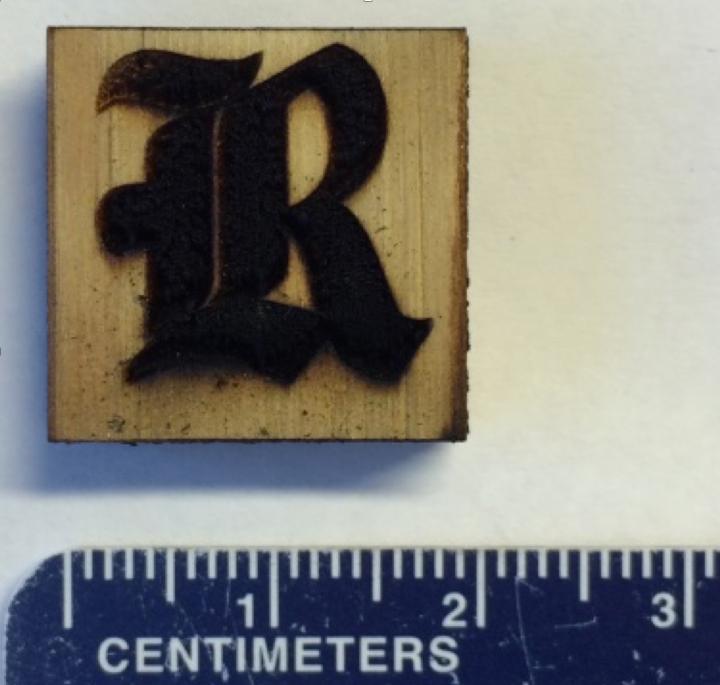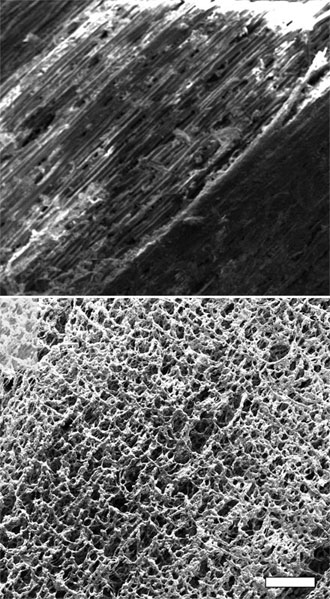
Rice Team Patterns Laser-Induced Graphene on Wood
source:photonics
release:Nick
keywords: Laser Laser application
Time:2017-09-04
HOUSTON, Aug. 28, 2017 — A team at Rice University has patterned a thin film of laser-induced graphene (LIG) on a block of pine using CO2 laser scribing. Previous iterations of LIG have been made by heating the surface of a sheet of polyimide with a laser.
Turning wood into graphene could open new avenues for the synthesis of LIG. Because of its high electrical conductivity, graphene patterned on wood surfaces could be fabricated into various high-performance devices, such as hydrogen and oxygen electrodes for water splitting and supercapacitors for energy storage.

Turning wood into graphene could open new avenues for the synthesis of LIG. Because of its high electrical conductivity, graphene patterned on wood surfaces could be fabricated into various high-performance devices, such as hydrogen and oxygen electrodes for water splitting and supercapacitors for energy storage.

This Rice University athletics logo is made of laser-induced graphene on a block of pine. Rice scientists used an industrial laser to heat the wood and turned its surface into highly conductive graphene. The material could be used for biodegradable electronics. Courtesy of Tour Group/Rice University.
“For some applications, such as three-dimensional graphene printing, polyimide may not be an ideal substrate,” said Ruquan Ye, a graduate student at Rice who led the study alongside fellow graduate student Yieu Chyan. “In addition, wood is abundant and renewable.”
Some woods are preferred over others, Rice chemist James Tour said. The research team found that pine's cross-linked lignocellulose structure made it better for the production of high-quality graphene than woods with a lower lignin content, such as birch and oak. Lignin is the complex organic polymer that forms rigid cell walls in wood.
Similar to making LIG from polyimide, the process for making LIG from wood uses a standard industrial laser at room temperature and pressure, in an inert argon or hydrogen atmosphere. With no oxygen, the heat from the laser does not burn the pine, but creates flakes of graphene foam that bind to the wood surface.
In experiments, when researchers changed the laser’s power, the chemical composition and thermal stability of the resulting LIG also changed. Researchers found that at 70 percent power, the laser produced the highest quality of what was dubbed “P-LIG,” where the P stands for “pine.”

“For some applications, such as three-dimensional graphene printing, polyimide may not be an ideal substrate,” said Ruquan Ye, a graduate student at Rice who led the study alongside fellow graduate student Yieu Chyan. “In addition, wood is abundant and renewable.”
Some woods are preferred over others, Rice chemist James Tour said. The research team found that pine's cross-linked lignocellulose structure made it better for the production of high-quality graphene than woods with a lower lignin content, such as birch and oak. Lignin is the complex organic polymer that forms rigid cell walls in wood.
Similar to making LIG from polyimide, the process for making LIG from wood uses a standard industrial laser at room temperature and pressure, in an inert argon or hydrogen atmosphere. With no oxygen, the heat from the laser does not burn the pine, but creates flakes of graphene foam that bind to the wood surface.
In experiments, when researchers changed the laser’s power, the chemical composition and thermal stability of the resulting LIG also changed. Researchers found that at 70 percent power, the laser produced the highest quality of what was dubbed “P-LIG,” where the P stands for “pine.”

Scanning electron microscope images show pristine pine at top and laser-induced graphene on pine (P-LIG) produced at Rice University at bottom. The scale bar is about 500 micrometers. Courtesy of Tour Group/Rice University.
The lab took its discovery a step further by turning P-LIG into electrodes for splitting water into hydrogen and oxygen. Researchers deposited layers of cobalt and phosphorus or nickel and iron onto P-LIG to make a pair of electrocatalysts with high surface areas that proved to be durable and effective.
The team also turned P-LIG into supercapacitors for energy storage. Depositing polyaniline onto P-LIG turned it into an energy-storing supercapacitor that had usable performance metrics, Tour said.
The versatility of this technique for making LIG could inspire both research and industrial interest in the development of wood-derived graphene materials and their nanodevices.
“There are more applications to explore,” Ye said. “For example, we could use P-LIG in the integration of solar energy for photosynthesis. We believe this discovery will inspire scientists to think about how we could engineer the natural resources that surround us into better-functioning materials.”
Tour saw a more immediate environmental benefit from biodegradable electronics.
“Graphene is a thin sheet of a naturally occurring mineral – graphite – so we would be sending it back to the ground from which it came, along with the wood platform instead of to a landfill full of electronics parts,” Tour said.
The lab took its discovery a step further by turning P-LIG into electrodes for splitting water into hydrogen and oxygen. Researchers deposited layers of cobalt and phosphorus or nickel and iron onto P-LIG to make a pair of electrocatalysts with high surface areas that proved to be durable and effective.
The team also turned P-LIG into supercapacitors for energy storage. Depositing polyaniline onto P-LIG turned it into an energy-storing supercapacitor that had usable performance metrics, Tour said.
The versatility of this technique for making LIG could inspire both research and industrial interest in the development of wood-derived graphene materials and their nanodevices.
“There are more applications to explore,” Ye said. “For example, we could use P-LIG in the integration of solar energy for photosynthesis. We believe this discovery will inspire scientists to think about how we could engineer the natural resources that surround us into better-functioning materials.”
Tour saw a more immediate environmental benefit from biodegradable electronics.
“Graphene is a thin sheet of a naturally occurring mineral – graphite – so we would be sending it back to the ground from which it came, along with the wood platform instead of to a landfill full of electronics parts,” Tour said.
MOST READ
- RoboSense is to Produce the First Chinese Multi-beam LiDAR
- China is to Accelerate the Development of Laser Hardening Application
- Han’s Laser Buys Canadian Fiber Specialist CorActive
- SPI Lasers continues it expansion in China, appointing a dedicated Sales Director
- Laser Coating Removal Robot for Aircraft
PRODUCTS
 FISBA exhibits Customized Solutions for Minimally Invasive Medical Endoscopic Devices at COMPAMED in
FISBA exhibits Customized Solutions for Minimally Invasive Medical Endoscopic Devices at COMPAMED in New Active Alignment System for the Coupling of Photonic Structures to Fiber Arrays
New Active Alignment System for the Coupling of Photonic Structures to Fiber Arrays A new industrial compression module by Amplitude
A new industrial compression module by Amplitude Menhir Photonics Introduces the MENHIR-1550 The Industry's First Turnkey Femtosecond Laser of
Menhir Photonics Introduces the MENHIR-1550 The Industry's First Turnkey Femtosecond Laser of Shenzhen DNE Laser introduced new generation D-FAST cutting machine (12000 W)
more>>
Shenzhen DNE Laser introduced new generation D-FAST cutting machine (12000 W)
more>>
